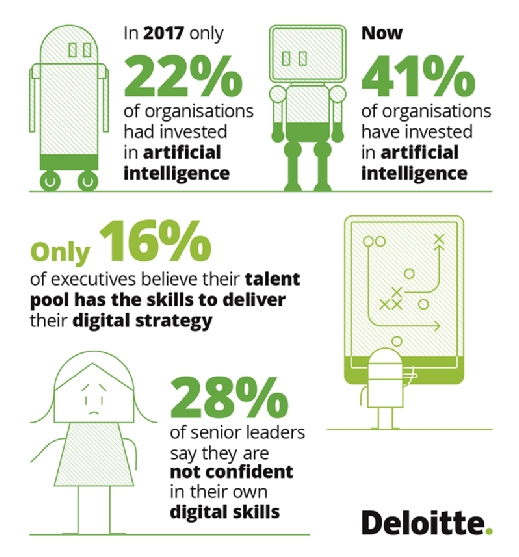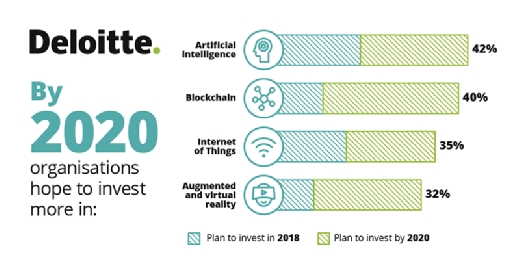
Sashkin - stock.adobe.com
Firms step up spending on digital tech, but struggle with strategy
Businesses and the public sector are stepping up their spending on digital technology, but many business leaders are struggling to keep pace with what it means for their business
Organisations have stepped up their spending on cutting-edge technologies, including artificial intelligence, blockchain and virtual reality, over the past 12 months, but many are struggling to develop a coherent strategy for their investment plans, according to research by Deloitte.
The consulting and audit firm’s Digital Disruption Index, which surveyed executives in more than 100 FTSE companies, revealed that most executives feel they lack the skills and confidence to lead their organisations through the changes that digital technology will bring, and company leaders are concerned that their organisations lack people with the right knowledge and skills to deliver their digital strategies.
Over the past 12 months, the proportion of companies putting resources into artificial intelligence (AI) has nearly doubled to over 40%, according to Deloitte’s Digital Disruption Index. By 2020, some 40% said they would have invested in blockchain, 35% in the internet of things (IoT), and 32% in virtual reality (VR) and augmented reality (AR).
Digital skills gap
But to make the most of these technologies, organisations will need to develop training strategies that help executives and employees develop the skills they need.
“Companies need to improve the quality of their learning and development programmes. There was quite a clear call out that a lot of learning and development programmes don’t help much by supporting their leadership in this type of skill,” said Oliver Vernon-Harcourt, partner for digital transformation in Deloitte.
One way to get managers up to speed on disruptive technology is to offer digital leadership programmes, which allow executives to learn from the way their customers use technology and give them time to step back and think about the implications of the technology for their organisations.

Executives can also do a lot to educate themselves, for example by experimenting with the latest gadgets, watching how their children use them, or using free resources online.
“There is a huge proliferation of fantastic content on YouTube, LinkedIn and through TED talks. There is a lot of general content for digital leaders,” said Vernon-Harcourt in an interview with Computer Weekly.
Over three-quarters of organisations are experiencing challenges in recruiting people with digital skills, with data scientists and analysts proving the most difficult to recruit and retain.
The majority of executives believe there are not enough school-leavers and graduates entering the labour market with the digital skills and experience they need.
This problem could be exacerbated by the impact of Brexit and immigration controls, which, according to estimates by Deloitte, could lead to 36% of the UK’s non-British workforce leaving in the next five years.
Organisations should identify the core skills they will need over the long term and start building capabilities in those areas, said Vernon-Harcourt.
“It does not have to be a huge team straight away. You can build as you go and learn as you go. Experiment and learn by doing. There may be startups or other organisations you can partner with,” he said.
Virtual reality
Executives predict that digital technology will have the greatest impact by giving them new ways to interact with customers, providing companies with actionable insights through better analysis of data, and helping the whole organisation to be more innovative.
In the public sector, executives are focusing on using technology to introduce cultural change, empowering and enabling employees, and reducing costs.

By 2020, half of the companies surveyed expect to have invested in VR and AR technologies.
Augmented reality, which allows employees to view information overlaid on a screen or glasses, is likely to find the widest range of applications in business, said Vernon-Harcourt.
For example, retailers could use augmented shopping apps on mobile phones to allow customers to see how furniture would look in their own homes; engineers could use AR apps, which overlay schematics or manuals to help them fix a problem out in the field; and data analysts could use AR headsets to visualise huge quantities of data, without feeling overwhelmed.
Blockchain
Over the next five years, Deloitte predicts that blockchain will shift from being an experimental technology to find more mainstream applications, particularly in the financial, manufacturing and consumer industries.
There are still technical challenges to overcome, including the lack of any agreed technical standards to ensure that different blockchain technologies can work together, said Vernon-Harcourt.
“It uses a significant amount of energy to mine bitcoins. If you are going to expand that to every financial transaction, the consumption of power problem needs solving.”
Artificial intelligence
Artificial intelligence is already having an impact on organisations, with many moving from production pilots into large-scale implementations.
Despite this, just 23% of executives believe their leadership has a clear understanding of AI and how it will affect the enterprise and the workforce.
Organisations believe AI technologies will have the greatest impact in business operations, product service and delivery, and customer care.
They predict that AI will replace simple rules-based tasks, which will improve services to customers and create more meaningful work for employees.
AI will not replace humans, said Deloitte, and organisations will gain the greatest advantage by seeing AI as complementary to human skills.
Internet of things
The internet of things (IoT) will find particular applications in the supply chain industry, said Vernon-Harcourt. Retailers have been tagging their products with radio frequency identification (RFID) tags for some time, but the real benefits will come when companies integrate internet-connected devices across the entire business.
“If your lorries are connected to the internet, shipping containers connected to the internet, products connected to the internet, and your factory is connected – you have a really powerful dataset and can make sure you have the right products at the right time,” he said.
Other technologies, such as 3D printing, will find applications in relevant industries, for spare parts manufacturing for example. Drones are being used experimentally in warehouses for stock taking, identifying gaps in shelves and detecting spillages.










